After Taking Night rest we decided to Explore the nearby Areas of Leh. As we came via Manali , therefore, the acclimatization problem was not there. But if you are reaching by Flight then at least 2 days required to get acclimatization. Though we thought of going Tso Mori Lake, But due to paucity of time we restricted our self to Leh and Nearby areas. To visit Nearby areas the best way to go for site seeing by Bikes. There are lot of shops available therefor this purpose. For ths purpose we four friends hire two bike and started exploring the nearby tourist areas.
Exploring Leh Ladakh can be a great experience as these places have a lot of natural beauty. There are a number of attractions in Leh Ladakh that are filled with extreme pristine beauty, the list is inclusive of well- known ancient monasteries, other religious sites, palaces of the royalty, various gompas, mountain peaks, wildlife safaris, adventure activity spots and much more. Ladakh with a unique characteristic that is a blend of Indian, Tibetan as well as Buddhism linings make it a place which is worth paying a visit.
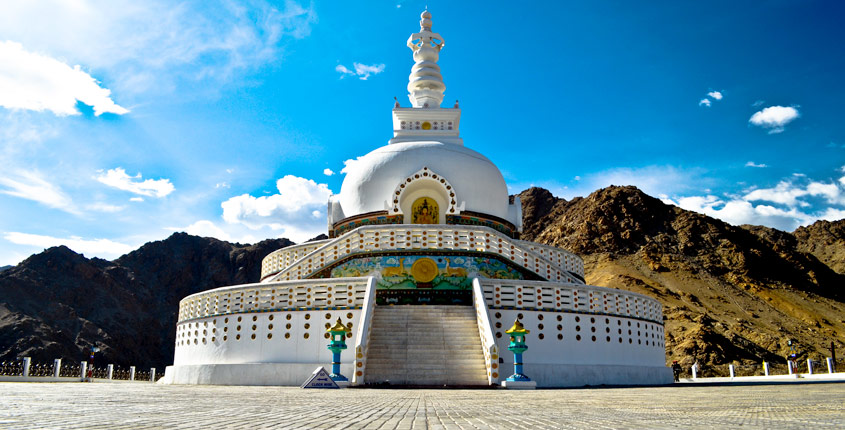
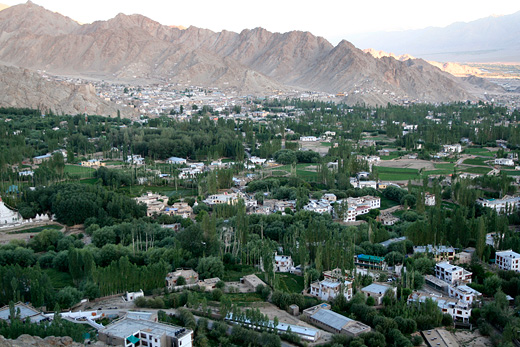
Photo: Leh town from Shanti Stupa

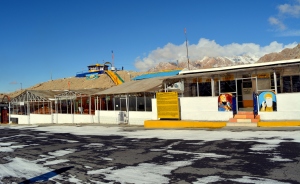
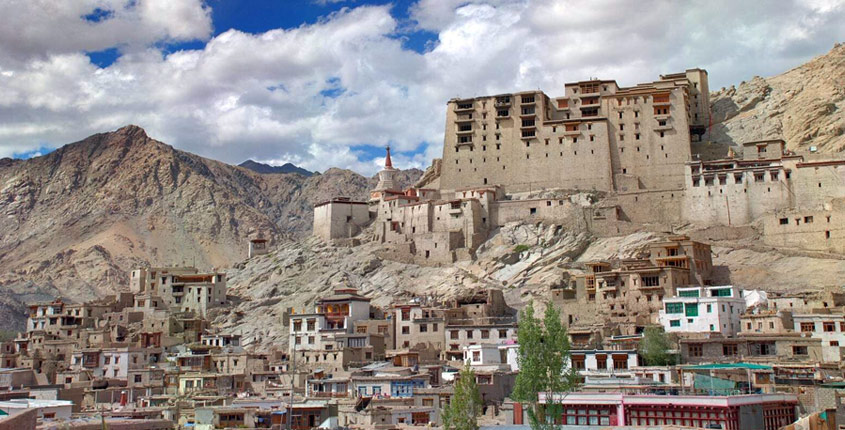

Photo: leh gate
When you enter the Leh the majestic gate with nice paintings on this welcome you. the paintings are Buddhist related paintings. This gate helps the administration to control the flow of traffic and others.
Leh market is divided into different areas , and where you can bye the things which you required. Like Handicrafts, other leh specific items, fruit market etc.

Photo: A handicraft Shop in Leh market

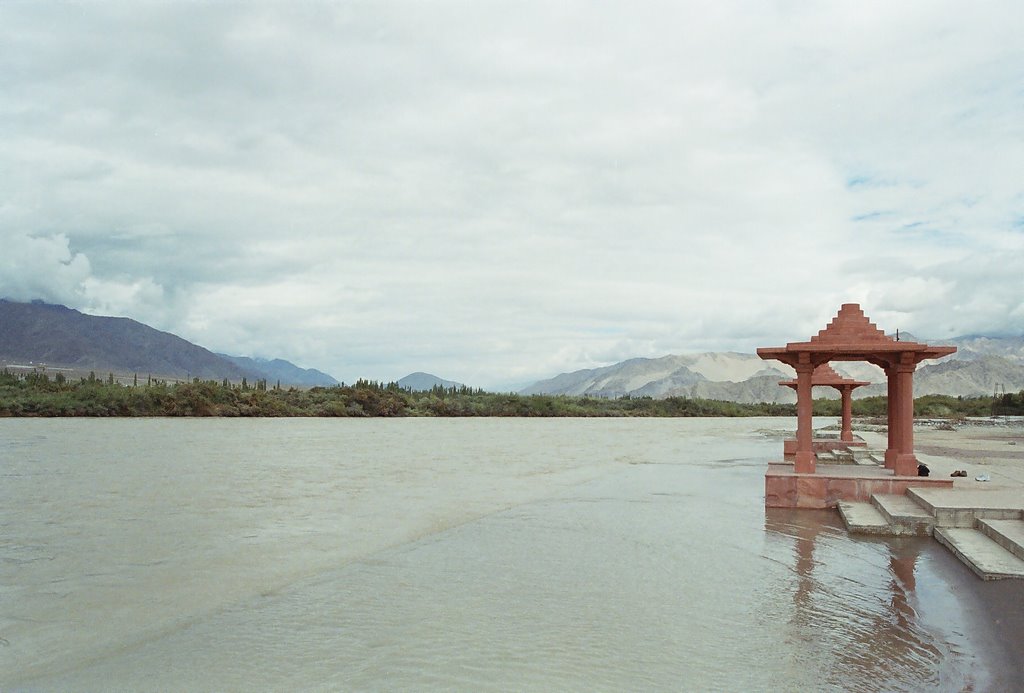
Photo: Sindhu Ghat, Leh
Though day time it is little hot . but evening time its so good that by in the chilled water all of your tiredness will go away and you feel very refreshed. It is around 10 Km from the leh, towards Upasi from Leh.
An important symbolic activity of ‘mingling of cultures’ by pouring waters from some of the other major rivers of India such as Brahmaputra, Ganga, Godavari, Cauvery and Yamuna into the Sindhu takes place during the main ceremony. Other activities like cultural entertainment by the locals as well as cultural troupes from other regions and states make the three day festival pretty interesting and colourful. During the year 2004, a Sindhi priest, Sadhuram Saheb, from Pakistan was a special invitee of the Sindhi Academy.
Whilst promoting tourism to this area, this festival is also a symbolic salute to the brave soldiers of India who have bravely fought the odds at Siachin, Kargil & other places. The Sindhu Darshan Festival will help forge a bond of unity with those who live in far-flung corners of the country and provide an opportunity to visit the beautiful region of Ladakh
This complex will be helpful in bringing out the unique culture of the Ladakh region and its people.The facilities proposed at the complex include an auditorium for seating 500 people, an open-air theatre, an exhibition gallery, a music room, a small library and a souvenir shop where Ladakh handicrafts could be available to visiting tourists.

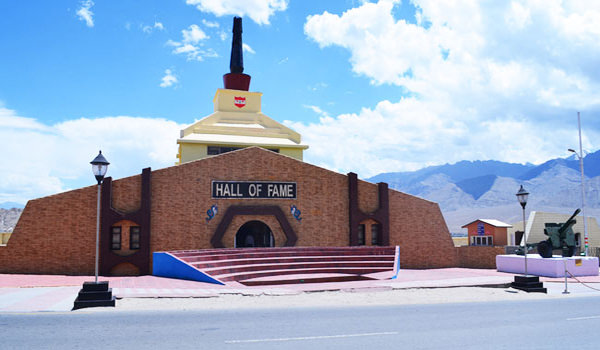
Other Important adventures visit ladakh Tourism , like Khardungala Biking, Trekking, Zansker River Rafting, Nubra valley etc.
Exploring Leh Ladakh can be a great experience as these places have a lot of natural beauty. There are a number of attractions in Leh Ladakh that are filled with extreme pristine beauty, the list is inclusive of well- known ancient monasteries, other religious sites, palaces of the royalty, various gompas, mountain peaks, wildlife safaris, adventure activity spots and much more. Ladakh with a unique characteristic that is a blend of Indian, Tibetan as well as Buddhism linings make it a place which is worth paying a visit.
1.Shanti Stupa
The first destination of Leh and sarrounding areas was Shanti Stupa. The Shanti Stupa is white-colored domed-shaped structure, located in Chandspa which looks extremely beautiful during night when it is illuminated. This peace pillar was built a ‘peace sect’ of Japanese Buddhist organization to celebrate the completion of 2500 years of Buddhism and for the promotion of world peace. It was inaugurated by His Holiness, the Dalai Lama in 1985. This pillar is known for its gilt panels depicting the life stories of Lord Buddha.
Photo : Shanti Stupa , Leh
It is just 5 kms away from the main city of Leh and is surrounded the traditionally built houses of the locals and snow-covered mountains. Take the steep slights to reach the Stupa that offers beautiful sunrise and sunset views . it also give beautiful View of Leh town.
Photo: Leh town from Shanti Stupa
2.Sangam( The confluence of Mighty Indus and Zanskar Rivers)

Photo: Confluence of Indus River (Blue) and Zanskar River (Green/muddy)
The confluence of these two mighty rivers of ladakh one of the siteto watch which no travelers should miss. It is around 35 Km from Leh to Kargil -Srinagar road. The clear Demarcation of waters, Blue ( Indus) and Green or Muddy is Zanskar. the confluence is near Nimmu Village, which is having a small Hydro power plant which will cater the energy need of the region. Another important thing that Chadar Trek startts from Nimmu during winter. Zanskar river forms the most spectacular Gorge , and people names it as Grand Canyon of Himalaya. During the Summer there is rafting and Kayaking at the confluence. However both activities are adventure sports and not for Faint hearted. before starting these you have to give a declation that you are taking these activities at your own Risk.The Indus is having rapids of categories 1 and 2 while at some points 3and 5 grade rapids also found. Most of the Raft ride starts from Phey to Nimmo, and Pushe to Nimo. The average charge per person is 1000 to 2000 rupees.
3. Magnetic Hill- thy Mystery or some science!!
It is a small stretch of road located about 30 kms from Leh towards Kargil and known as Magnetic Hill of Ladakh. On this particular part of the Srinagar-Leh highway, you would clearly see the road ahead going uphill. Yet if you turned off the engine and let your vehicle stand in neutral, it will slowly start moving and can go up to a speed of 20 kms per hour on its own. Mysterious?
Photo : Magnetic Hill, Leh
What is believed to be at work behind this mysterious phenomenon is a
magnetic force so strong that it can pull cars uphill. It is in fact so
notorious that even the aircrafts that fly over this region increase
their altitude in order to avoid magnetic interference. Every tourist
driver that passes through here would kill the engine to let the
tourists experience how the car still kept moving. Some people are not
aware about Magnetic Hill and just pass through here but the ones who do
know stop their cars to verify whether what they heard was true or
merely a made-up tale.
There is a concept of optical illusion
in neuroscience which in layman’s language means that you either see
something that is not there at all or you see things different than how
they physically are. Out of the numerous optical illusions recorded,
there is one of Gravity Hill which means that a very slight downhill
slope appears to be an uphill slope. Why it appears that way can
actually be attributed to obstructed horizon, either completely or
mostly. Our eyes and minds are used to using the horizon as a reliable
reference to be able to tell if a particular slope is straight or if
there is a slant. Without the horizon, we will not be able to tell for
sure. The same concept works in aviation as well. Pilots up in the sky
cannot see the horizon and if it weren’t for the electronic equipments
and gadgets, they would never be able to tell if the plane is flying
straight, upwards or downwards. If the horizon is obstructed, our minds
get confused and can often perceive things to be horizontal or vertical
when they are actually not. This illusion is much similar to that of
Moon Illusion where the moon appears to be much large to the horizon or
Ames room Illusion where balls can appear to roll against gravity.
There are several such mistakenly
characterized Gravity Hills all over the world. Several roads that
appear to be going uphill while the slant is actually downhill. There
are rivers that appear to be defying gravity and flowing uphill which is
again an optical illusion because the water is in fact flowing
downhill. Tulsishyam in Gujarat, Electric Brae in Scotland and Gansu in
China are just a few examples of such places.
This same concept applies to our
Magnetic Hill in Ladakh. This is purely a natural optical effect caused
by the specific layout of hills that obstruct the horizon. That short
stretch of the road that appears to be uphill as a matter of fact is
downhill and this is the reason why cars slowly gain momentum. The hills
in front of your eyes at this stretch are naturally laid out in such a
manner that they will deceive your mind and lead it to believe that you
are going up. Since your eyes cannot clearly see the horizon, there is
no way for your mind to contradict.
4 Gurudwara Paththar sahib
Gurdwara Pathar Sahib, is a beautiful Gurudwara sahib constructed in the memory of Guru Nanak, about 25 Km away from Leh, on the Leh-Kargil road, 12000 ft above sea level. The Gurdwara was built in 1517 to commemorate the visit to the Ladakh region of Guru Nanak Dev, the founder Guru of the Sikh faith.

The Gurdwara was built to commemorate the visit of Guru Nanak Dev Ji, in 1517 to the Ladakh region.
During his lifetime Guru Sahib travelled to many distant places and one
such place was Tibet and Ladkh. Guru Nanak is immensely respected by
Tibetan Buddhists who consider him as a Buddhist saint under the name
of Guru Gompka Maharaj. In the late 1970s, during the construction of
the Leh-Nimu road, a large boulder was found by Lamas in the middle of
the road bed covered with Buddhists prayer flags. Such prayer flags
are often found, strung by Buddhist Lamas, along mountain ridges and
peaks high in the Himalayas to bless the surrounding countryside. The
bulldozer driver tried to push the huge stone to the side, but it
refused to move. Suddenly, with a large snap, the blade broke and the
work stopped. Several Lamas and other Ladhakhis told the story of a
Holy Saint they called Nanak Lama and the unyielding boulder. The
learned lammas told that the pathar the road crew had been having so
much trouble with was a ‘mould’ with a negative impression, of their
revered LamaNanak that contained a hollow imprint of his shoulders, head
and backside. Today the site and the Gurdwara that now covers the
boulder is revered by both the local Lamas and Sikh sangat. This
Gurdwara is looked after by the Indian Army. According to a local
legend, once a wicked demon live in the area who terrorized the people
where the gurdwara is now situated. The people prayed to the Almighty
for help. It is said that Guru Nanak heard their woes and came to their
aid. He settled down on the bank of the river below the hill where the
demon lived. The Guru blessed the people with sermons and became popular
in the area. The locals called him Nanak Lama. Seeing this, the demon
got into a rage and decided to kill Guru Nanak Dev. One morning when the
Guru was sitting in meditation, the demon pushed a large pathar
(boulder), down from the hilltop, with the intention to kill the Guru.
The boulder gained speed as it rumbled down the hillside, but when it
touched the Guru’s body, it softened like warm wax and came to a halt
against Guru Nanak’s back. The Guru kept on meditating unhurt and
undisturbed. Thinking that the Guru had been killed, the demon came down
and was taken aback to see the Guru deep in meditation. In a fit of
anger, he tried to push the boulder with his right foot, but as the
pathar still had the softness of warm wax, his foot got embedded in it.
Pulling his foot from the boulder the demon was dumfounded to see the
impression of his foot in the stone. On seeing this, the demon
realized his own powerlessness in front of spiritual power of the great
Guru. He fell at the feet of Guru Nanak Dev and begged for forgiveness.
Guru Sahib advised him to get rid of his wicked ways and asked him to
lead a life of a noble person. This changed the life of the demon, who
gave up evil deeds and started serving the people. The pathar pushed
down by the demon, with the imprint of the body of Guru Nanak Dev and
the footprint of the demon, is at present on display in Gurdwara Pathar
Sahib. It is said that since the visit of Guru Sahib (in 1517) to the
building of the road way in 1965-1970, the local Lamas had held the
pathar sacred and offered prayers to it as, no doubt, they do to this
day.
5 Leh Palace

Photo: Leh Palace
Leh Palace was built during the 17th century by the ruler King Sengge Namgyal. Its construction is on the same lines as the construction of the Potala Palace in Lhasa, Tibet. This palace had to be deserted by the royal family in the middle of the 19th century, because of the taking over of Ladakh by Dogra forces. After this the royal family is living in-exile in the popular Stok Palace. The Archaeological Survey of India (ASI) is restoring some of the ruined portions of this nine-storey palace. While the store rooms were on the lower floors, the royalty resided on the upper floors. The roof of this palace offers an excellent view of the valley.
6. Leh Market and Gate

Photo: leh gate
When you enter the Leh the majestic gate with nice paintings on this welcome you. the paintings are Buddhist related paintings. This gate helps the administration to control the flow of traffic and others.
Leh market is divided into different areas , and where you can bye the things which you required. Like Handicrafts, other leh specific items, fruit market etc.

Photo: A handicraft Shop in Leh market
7. Hemis Monestry

Hemis Gompa is located in Hemis, a small town just about forty five
kilometres to the south east of Leh. Hemis has a national park, and is
home to the endangered Snow Leopard. This gompa is held in great esteem
one of the largest ones in Ladakh, with more than 200 branches and 1000
monks across the Himalayas. It has a large copper statue of the Buddha
and stupas made of gold and silver, making the gompa the wealthiest one
in India.
The Tibetan-style architecture used is colourful and the
gompa includes beautiful murals. People are unsure of the exact date
when the Hemis Gompa (monastery) was founded. Historians are certain
that it existed before the eleventh century. It is said that the
legendary Naropa Yogi was associated with the monastery. Sengge Namgyal,
the great ruler and commander of the Namgyal dynasty is said to have
re-established the monastery, sometime towards the end of the sixteenth
century.
The Gompa comprises two major structures – a temple, and
the main assembly hall. There are a number of valuable pieces of art
here, including thangkas, frescoes, paintings and statues. There is a
cave here which is believed to have the imprints of the sage Gyalwa
Kotsang.
Hemis Gompa also has an interesting story. Nicolas
Notovitch, a Russian journalist said that he had seen a rather unknown
(and discredited) gospel in the gompa. He claimed that the gospel
declared that Jesus travelled to India during his unknown years (before
the beginning of his ministry). However, years later, Notovitch admitted
that it was all a hoax he had created in 1894.
Hemis Gompa hosts
the annual Hemis festival in early June. The festival honours the
Padmasambhava and his birth, which was predicted by the Buddha in his
Sakyamuni avatar. People gather to watch the festivities and mask
dances.
8. Indus Darshan

Photo: Sindhu Ghat, Leh
Though day time it is little hot . but evening time its so good that by in the chilled water all of your tiredness will go away and you feel very refreshed. It is around 10 Km from the leh, towards Upasi from Leh.
Sindhu Darshan-the festival at Leh that has been quite recently
established as an annual national affair of India. The venue of the
programme centres around the Sindhu Ghat between Choglamsar and Shey,
on the banks of the river Indus. The event is a part-tourism,
part-nationalism and is meant to be an ode to the great trans-Himalayan
river and intends to serve multiple purposes.
Perhaps, driven by nostalgia for the place of his birth (Sindh), the then previous home minister of India, L. K. Advani started an annual festival to highlight the spirit of unity that underlies India’s dazzling cultural diversity, way back in 1997. Today, it has grown into a major event in the Union Tourism Ministry’s annual calendar. Most importantly, it serves to promote tourism in Ladakh in particular.
Perhaps, driven by nostalgia for the place of his birth (Sindh), the then previous home minister of India, L. K. Advani started an annual festival to highlight the spirit of unity that underlies India’s dazzling cultural diversity, way back in 1997. Today, it has grown into a major event in the Union Tourism Ministry’s annual calendar. Most importantly, it serves to promote tourism in Ladakh in particular.
An important symbolic activity of ‘mingling of cultures’ by pouring waters from some of the other major rivers of India such as Brahmaputra, Ganga, Godavari, Cauvery and Yamuna into the Sindhu takes place during the main ceremony. Other activities like cultural entertainment by the locals as well as cultural troupes from other regions and states make the three day festival pretty interesting and colourful. During the year 2004, a Sindhi priest, Sadhuram Saheb, from Pakistan was a special invitee of the Sindhi Academy.
Whilst promoting tourism to this area, this festival is also a symbolic salute to the brave soldiers of India who have bravely fought the odds at Siachin, Kargil & other places. The Sindhu Darshan Festival will help forge a bond of unity with those who live in far-flung corners of the country and provide an opportunity to visit the beautiful region of Ladakh
This complex will be helpful in bringing out the unique culture of the Ladakh region and its people.The facilities proposed at the complex include an auditorium for seating 500 people, an open-air theatre, an exhibition gallery, a music room, a small library and a souvenir shop where Ladakh handicrafts could be available to visiting tourists.
9.Thiksey Monestry
Spituk
is yet another interesting monastery, on the hill top near Indus about
18 kms. from Leh on Srinagar road. The Spituk monastery offers a
commanding view of Indus. It has a totally new Gompa within the
monastery as well as the old Gompa has also been restored meanwhile. It
is constructed in a series of tiers with courtyards and steps. Higher up
in the hill is a chamber which houses the enormous statue of goddess.
Its face is covered and uncovered only once in a year during the
festival time.The Spituk Gompa was founded in 11th century by Od-De, the
elder brother of Lha Lama Changchub-od. The Gompa was named Spituk
(exemplary) by Rinchen Zangpo, a translator came to that place and said
that exemplary religious community would rise. Initially the Gompa was
run according to the Kadampa school then during the reign of king
Gragspa Bumide he converted it to Gayluk Pa order. Many icons of Buddha
and 5 thangkas can be visited in this 15th century monastery. The
Dukhang Hall is the largest building and has two rows of seats running
the length of the walls to a throne at the far end. Sculptures and
miniature chortens are displayed on the altar. There is also a
collection of ancient masks, antique arms and fine thangkas. Higher up
the hill is the Mahakal Temple, containing the shrine of Vajrabhairava.
The terrifying face of Vajrabhairva is unveiled only at the annual
festival in January.Every year, on the 17th and 19th day of the 11th of
the Bodhi month, the Gelukpa order of monks celebrate the Spituk
festival known as Gustor. During the festival, the lamas wear the masks
of religious deities and perform the dances, which is normally about
good and evil and mythological stories related to the Buddhism.
10 Hall of Fame Museum

The Hall of Fame, located near the Leh Airfiled, is a museum constructed
as well as maintained by the Indian Army in the memory of the soldiers
who had lost their lives during the Indo-Pak wars. It is also termed as a
memorial for the war heros. This building consists of two floors. While
on the ground floor, there is information about the brave soldiers as
and a souvenir shop but on the first floor, there are artifacts of
various wars (mainly Kargil war) such as the weapons used during the
war and some important documents, related to the same. There is another
section dedicated to the Siachen glacier. It is worth watching and you will feel that how difficult is life for soldier.
Other Important adventures visit ladakh Tourism , like Khardungala Biking, Trekking, Zansker River Rafting, Nubra valley etc.
